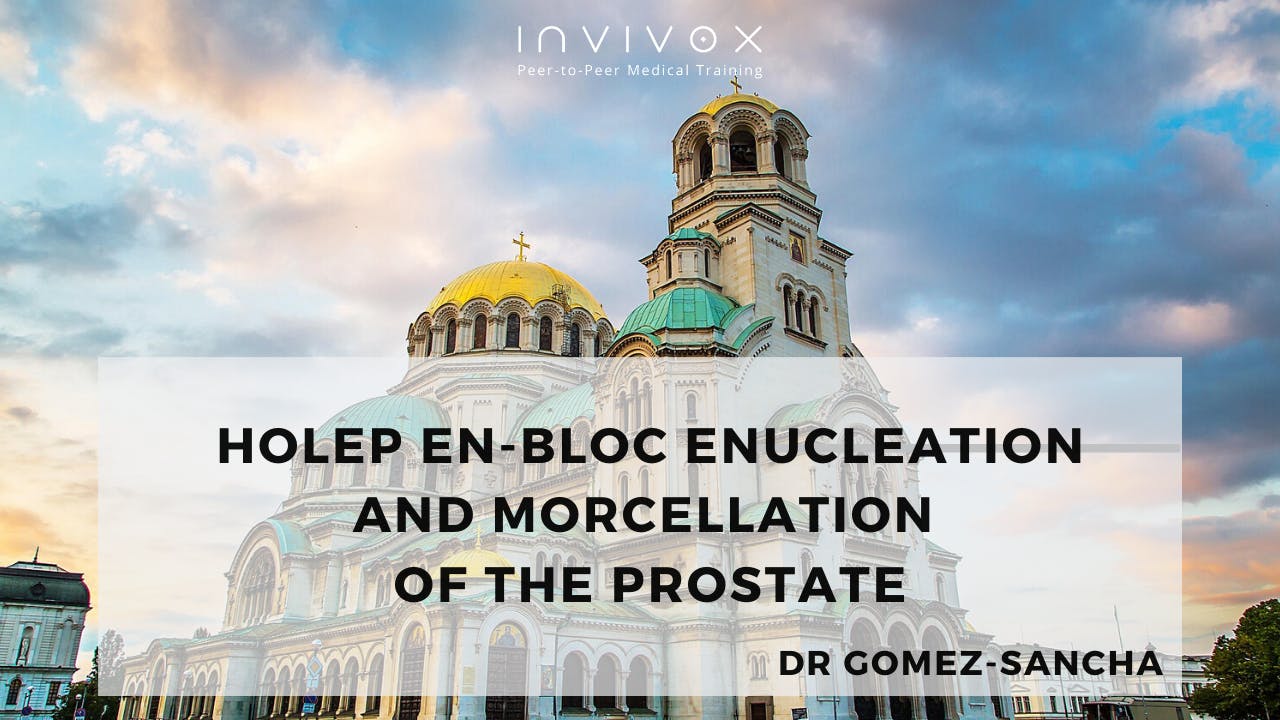INVIVOX : Why did you decide to implement this masterclass with regard to the HoLEP (Holmium Laser Enucleation of the Prostate) technique?
Dr Fernando GOMEZ SANCHA: I've been training surgeons for years, more than 15 years and it’s a fulfilling experience. This training gives the opportunity to learn in a unique place thanks to the concentration of many cases. I also learn a lot from trainees. We have time to talk and exchange, it’s not like a short visit. These are ideal conditions for acquiring the technique HoLEP which is really a very fast operation and easier to learn contrary to what we think. It provides a very good protection of urethral sphincter, patients have a low rate of incontinence. It’s better than a classic HoLEP in my opinion.
INVIVOX : Why your masterclass is different?
Dr Fernando Gomez Sancha : I go every month to Sofia in Bulgaria to operate. We’ve accumulated a lot of cases around 20 or 30 by month. So it’s a unique opportunity of training because when surgeons join a training session, they usually only see 3 or 4 operations. In Sofia, if they attend several days, they will see 8 or 9 cases in one day (more or less 32 cases for 4 days). During the session, they will really see many different indications and go home with a solid knowledge: big prostates, prostate’s cancers, patients who were operated before etc.
They will know how to do and how to solve problems. They will also be able to see the incredible teamwork we have in Sofia that is very important to the success of the HoLEP procedure.
"“It's really a course for urologists who want to commit to learn. They go back home and usually able to start.”"
INVIVOX : Is it an hands-on training?
Dr F. G. S.: Trainees watch what I do during the operations but we have a constant interaction. I think the most important before practicing HoLEP is to see a lot of operations. Doing hands-on without understanding is useless. It’s a first step in the learning. Trainees change their mind about HoLEP. They come in thinking it's difficult, there are a lot of details to look after and complicated interactions (nurses need to help to change the instruments for example) but we explain to them how simple it can be and we cover every aspects during these intensive 4 days. We also watch some videos with other techniques.
INVIVOX : Why is training with a surgeon learning curve particularly important in the HoLEP technique?
Dr F. G. S.: Traditionally the experience curve is considered to be rather long but with our approach it’s completely different and it’s better for patient. The learning curve is certainly shorter than that of laparoscopic procedures and RTUP. 20 to 30 patients are required for the urologist before they become familiar and feel reasonably safe with HoLEP. This number is considerably reduced if the learning is properly supervised.
INVIVOX : Do you teach participants to ask the indication correctly?
Dr F. G. S.: HoLEP is a very versatile technique and in absolute terms it is applicable to most patients with BPH. During course we discuss about different variations of how to do HoLEP to achieve different goals: for example if you want to preserve ejaculation or if you want that treatment to be definitive. So yes, we're studying the indications.
INVIVOX : Is HoLEP possible on large prostate adenomas (> 800 g)?
Dr F. G. S.: Definitively. In every session we have got several patients with a massive prostatic sizes. I operate on about 700 patients per year. I don't remember not being able to operate on a patient in the last 10 years.
INVIVOX : What steps will you show the participants (surgical approach, laser adjustment, enucleation, fragmentation etc.)?
Dr F. G. S.: This technique starts with cystoscopy (we look into the bladder and the anatomy of the prostate). We look also very carefully the anatomy of the sphincter and his relationship with the apex of the prostate. The first step is going to be to release the sphincter from the apex in order to protect the external urinary sphincter. When the apex has been freed, the dissection of the plane is very simple because we do a circumferential dissection. The plane is very easy to recognize, and we also benefit from an excellent irrigation, better than when we do a three piece technique. When we dislocate the adenoma into the bladder then it is fragmented into small pieces using a morcellator. We have to extract the tissues and we discuss of the safe way to do it. With this approach liberating the sphincter takes the first 10 minutes of operation, it’s more relaxed for surgeons after that moment because we know that sphincter is safe and it’s the most important consideration. But sometimes we have to tackle bleeders, small capsular perforations and we prepare attendees to manage this type of situations.
INVIVOX : Did you develop your own trips and tricks ? If yes, which one for example?
Dr F. G. S.: Most of surgeons who do HoLEP follow a classic approach (2 and 3 lobes technique). The initial approach to enucleation for me was with the green laser and the 3 lobes technique was not so good with a side firing fiber. I develop an en bloc approach with the green laser. Later I notice we obtain better results with HoLEP with the same en bloc technique. My HoLEP’s approach is not conventional. It comes from a fresh perspective based on a different “culture” using a green laser.
INVIVOX : How is HoLEP technique innovative in benign prostatic hyperplasia (BPH)??
Dr F. G. S.: Actually, we have very good data. More and more centers are making HoLEP so surgeons need to be trained and our en bloc approach shows that it's not as complicated as people think it is.
INVIVOX : Is the HoLEP in the way of replacing the transurethral resection of the prostate (TURP)?
Dr F. G. S.: In my opinion yes. There is nothing better in the treatment of BPH nowadays. Patients do not like the classic techniques.
INVIVOX : What are the 3 or 4 benefits that participants will get from this training?
Dr F. G. S.: I think it’s a definitive course in the sense that participants will see many cases, understand anatomy, how instruments are handled, how the team works: the organization in operating room is very important.
"“Trainees will leave with everything that they need to know to start their own experience.”"

